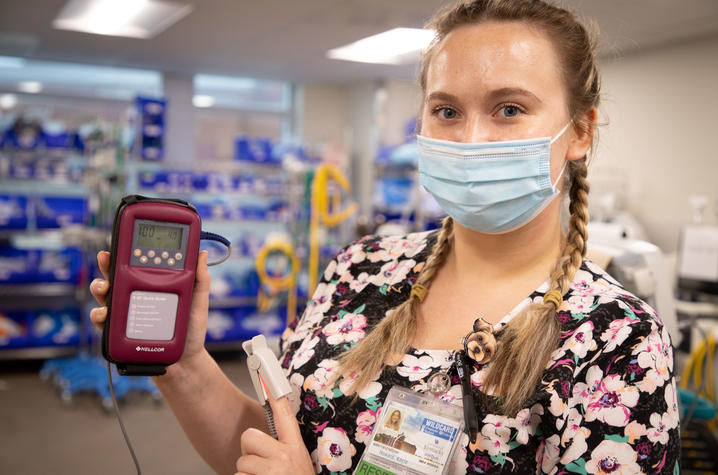Mask Up and Breathe Easy - Masks Have No Effect on Oxygen Levels
LEXINGTON, Ky. (Sept. 3, 2020) — Wearing a mask, while necessary and required at the University of Kentucky, can cause some people to feel anxious and panic. It's all a part of "anxiety sensitivity," a psychological trait that causes people to view certain physical sensations as uncomfortable or aversive, said Shannon Sauer-Zavala, an assistant professor in the University of Kentucky College of Arts & Sciences' Department of Psychology.
People who experience this trait may interpret minor changes in physiological sensations - like increased heart rate, changes in breathing rate, muscle tension - as a sign that something bad will happen. For example, it may cause a person to feel as if they're having a heart attack or feel as though they will pass out because they're concerned that they aren't getting enough air.
"Thinking that negative outcomes are likely to happen often makes people feel anxious and, of course, anxiety is associated with physiological changes, like a racing heart, shortness of breath and muscle changes," Sauer-Zavala said. "Depending on the type of COVID-related face covering, breathing may feel somewhat more strained than going without."
However, it should be noted that most non-medical masks allow for sufficient airflow.
Wearing a mask does not cause your oxygen levels to drop. UKNow caught up with Kayla Howard, a pediatric respiratory therapist, to put that theory to the test. She helped to demonstrate with a pulse oximeter, which measures your oxygen saturation level, or the oxygen levels in your blood. Meanwhile, Lisa Wright, a registered respiratory therapist (RRT) and manager of UKHC Respiratory Therapy, is helping us to better understand our health while wearing a mask.
For reference, when we talk about "oxygen levels" or "blood oxygen," we are referring to whether or not there is enough oxygen moving through the blood to support the organs.
UKNow: How are blood oxygen levels measured? Is there a range for healthy adults?
Wright: One measure of the blood oxygen level is the pulsatile oxygen saturation (SpO2). Oxygen saturation can be painlessly evaluated by placing a pulse oximeter over a finger. The pulse oximeter reports what percent hemoglobin molecules are carrying oxygen. A normal oxygen saturation for a healthy adult is 95% or greater.
UKNow: How exactly does a pulse oximeter work? How does it read oxygen levels?
Wright: Pulse oximeters measure the SpO2 by shining light through the finger. Sensors on one side of the probe detect the percentage of light that makes it across to the other side of the finger. Hemoglobin carrying oxygen absorbs more red light than unoxygenated hemoglobin. Using this bit of wavelength science, the sensor determines what percent of hemoglobin is saturated with oxygen.
UKNow: Does a facial covering obstruct air intake? What about the claims that masks trap CO2?
Wright: Facial coverings should not obstruct air intake or block CO2 from escaping. Surgeons and other people who work in operating rooms or perform sterile procedures wear masks all day, every day and have for their entire professional careers.
Face coverings are filters. They filter out larger particle invaders like viruses and bacteria but still let smaller particles in. The N95 masks that healthcare workers use when caring for COVID-19 patients filter out 95% of particles that are 0.3 microns or larger. Oxygen is .0005 microns. In other words, the molecules we breathe in and out are several magnitudes smaller than the infectious particles the face coverings are filtering out.
UKNow: When people claim they aren't getting enough oxygen because of a facial covering, is it accurate to say what they are experiencing is mild anxiety as a result of their discomfort?
Wright: Honestly, wearing a face covering does take getting used to. It is normal to feel uncomfortable with something over your nose and mouth. It's warm. Maybe your glasses are fogging up a bit. Maybe you are breathing a bit faster just because it feels weird.
One of the best analogies I read recently compared wearing a face covering to adapting to a snorkel. They don't feel natural and they take getting used to. It may help to "practice" by wearing a face covering indoors at home for short periods of time and then gradually increase the time that you have it on.
*****
"If a person is sensitive to these minor changes in physical sensations (i.e., slightly impeded airflow), they may also tell themselves that they can't breathe, which can actually provoke shortness of breath, which is a symptom of anxiety," Sauer-Zavala said. "It's all a vicious cycle."
While it's important to validate those feelings, Sauer-Zavala said closing your eyes and breathing slowly and deeply can help.

As the state’s flagship, land-grant institution, the University of Kentucky exists to advance the Commonwealth. We do that by preparing the next generation of leaders — placing students at the heart of everything we do — and transforming the lives of Kentuckians through education, research and creative work, service and health care. We pride ourselves on being a catalyst for breakthroughs and a force for healing, a place where ingenuity unfolds. It's all made possible by our people — visionaries, disruptors and pioneers — who make up 200 academic programs, a $476.5 million research and development enterprise and a world-class medical center, all on one campus.




